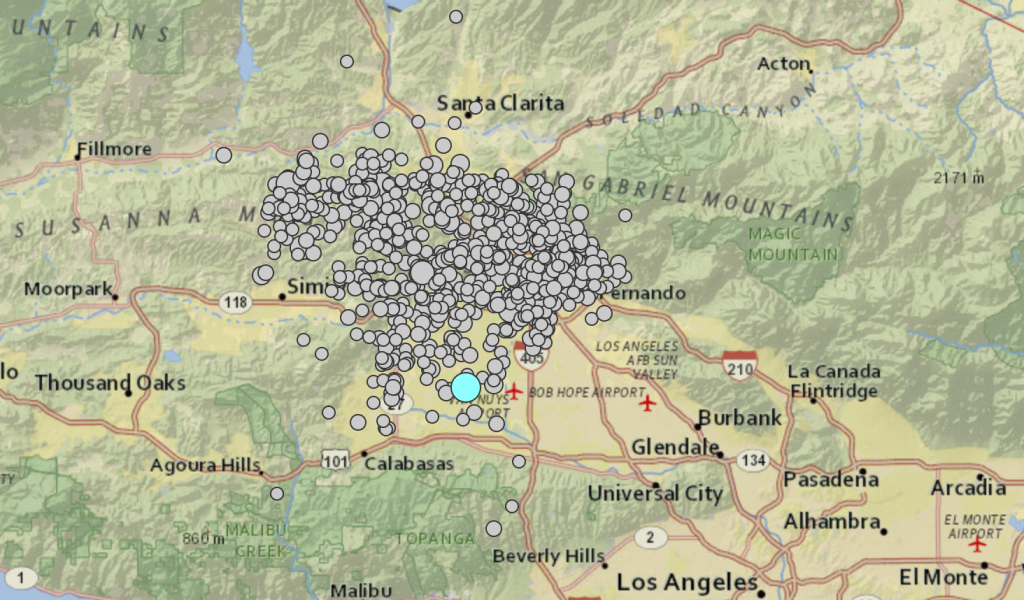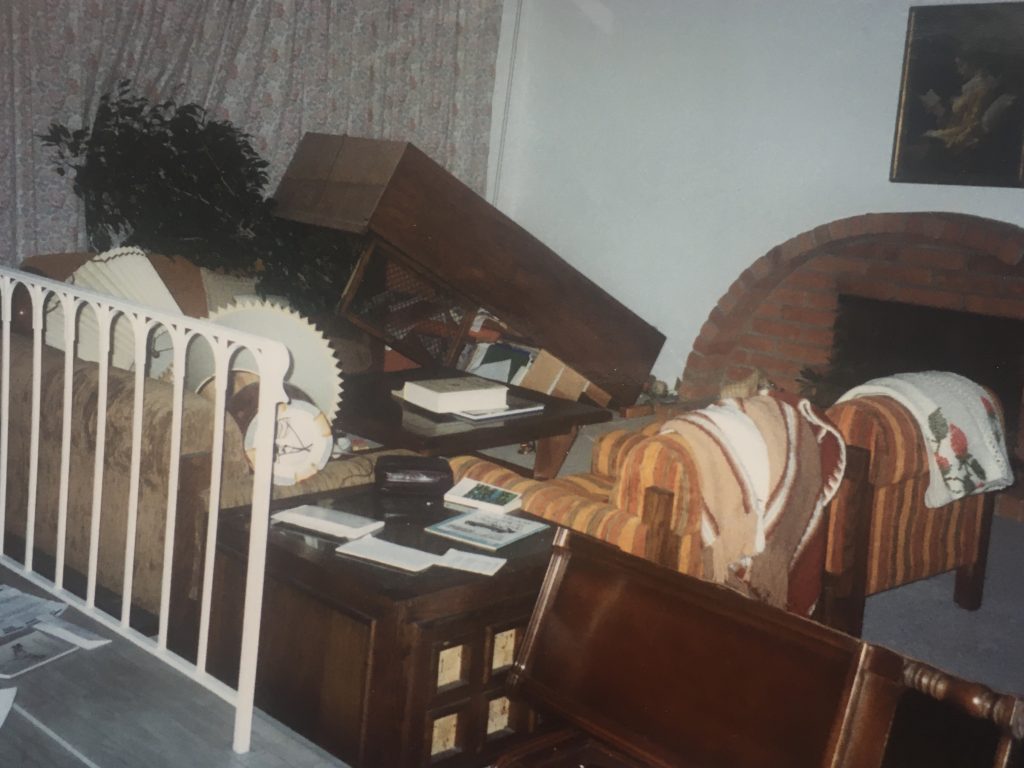Disasters
TOP STORY
Inside DPS
Protecting Utah
I wasn’t ready: What I learned during the 1994 Northridge Earthquake
Do you have a story to share that can help others prepare?
4:30 a.m. I was asleep.
But suddenly, I was awake. Lying in my bed and pulling a blanket over my head, as my room was shaken back and forth, as if a garbage truck were continuously ramming the house. I would have guessed the shaking lasted for a least a minute. I would be wrong though.
Twenty-six years ago today, January 17, 1994.
20 miles away from my family home in Simi Valley, California, and 11.4 miles underground, the earth had given a lurch on a previously undiscovered fault, sending waves of energy in every direction. It was a magnitude 6.7 earthquake, eventually named the Northridge Earthquake, one of the costliest disasters in U.S. history. According to the Southern California Earthquake Center, “The Northridge earthquake produced extremely strong ground shaking, which caused the greatest damage in the United States since the 1906 San Francisco earthquake.”

Once this tremendous energy struck my city, the shaking damaged homes, rendering 20,000 people homeless. It snapped natural gas lines and collapsed buildings and parking structures. Sections of freeway overpasses dropped to the ground. The roof of the local movie theater caved in. Thousands of people were injured. 57 people were killed. It took 20 seconds.
That’s all. 20 seconds of shaking.
I had been through earthquakes before. They were always unsettling, but you could always go back to sleep. This time was different. My sister screamed. My parents called through our rambler to make sure everyone was OK. But it was dark. So dark. The power was out, and would stay that way for days.
In darkness, you crave light, but all I had was my Indiglo watch. So I used its feeble turquoise light to survey the room I shared with my brother. A dresser had toppled. Bookcases disgorged dozens of book. The entire contents of my closet shelves were on the floor. It was a mess. We were OK, but it was a mess.

My parents were briefly blocked from leaving their room by a fallen armoire and as they saw the tiny light in my room. They asked what it was. “My watch!” I called out. “Good idea,” they said and went and found theirs.
And that was how we navigated until we could find flashlights and working batteries.
Lesson 1: Keep a flashlight by your bed
No. I don’t mean a cell phone that has a flashlight built in. I mean an actual flashlight with working batteries. In an extended power outage, you won’t be able to charge your cell phone (unless you’ve planned for that) so you’ll need to conserve its battery. Using the flashlight function will run that battery down. So get an actual flashlight. There are many LED flashlights out there that run on AAA batteries and will last for days.
Consider:
- An LED headlamp.
- Having extra batteries. You won’t be going to the store to pick up more.
- A solar charger to keep your cell phone going once the sun is up. You may be able to text loved ones in a quake.
- A battery powered LED lantern.
- One flashlight is not enough. Each family member should have one.
- Just pick up an extra flashlight next time you’re at the store.
Lesson 2: It’s not just 1 earthquake
We often refer to an earthquake by its name: Northridge, Loma Prieta, Whittier, Haiti, Mexico City, Christchurch. Naming it gives it a permanent sense, that it was something worth remembering. But the name doesn’t tell the full story. An earthquake is not a singular event.
Each earthquake creates aftershocks as the earth shifts. And in a major earthquake, like Northridge, there were thousands of aftershocks. We didn’t feel all of them, but we definitely felt the magnitude 6.0 aftershock that happened one minute after the main quake. Another magnitude 6 aftershock happened about 11 hours later.

Smaller aftershocks rattled my frazzled family, as we sat in the dark, wondering how long the aftershocks would last. Fortunately, they were short.
Consider:
- Aftershocks can be almost as large as the main quake.
- They can exacerbate damage done during the main quake.
- Treat aftershocks like the main quake. Remember to drop, cover and hold on. If you’re in bed, stay there.
- There will be thousands of aftershocks after an earthquake.
Lesson 3: Cleanup
In the kitchen, nearly every dish was flung to the floor and shattered. The refrigerator doors had been thrown open and its contents along with those of our food cupboards, mingled on the floor: BBQ sauce and eggs and cheese and pitchers and bacon were in an insane pile on the floor, as if gremlins had had some sort of terrible party.

Once the sun came up and we could see, we set about starting to clean up. It took days to put everything back. Eventually, we learned that part of our backyard cinderblock wall had partially fallen, our home’s foundation was cracked and our home had sustained about $40,000 in damage.
Though we didn’t have the foresight to have flashlights by our beds, my parents knew they lived in earthquake country and had purchased an earthquake insurance policy. Most of our disaster recovery was paid for because of an investment my parents made.
Consider:
- Your home is not covered for earthquake damage unless you have a separate policy.
- Don’t expect the federal government to pay for your disaster recovery.
- Most people do not have tens of thousands of dollars lying around to pay for extensive home repairs.
- Shop around because the first quote you get for a policy will make it seem too expensive.
- I have a whole-home replacement policy that costs $340 per year.
- Owners of newer, wood-frame homes, will have an easier time getting affordable insurance than owners of older unreinforced brick homes.
The new normal
It was months until home repairs were completed and that we felt like we were back to normal.

My junior high was damaged, and I was out of school for the week. Because of extensive damage to Simi Valley High School, my friends there did not return for the rest of the school year. Instead, the school district arranged for them to attend rival Royal High School on a half-day schedule for the rest of the school year.
My parents got flashlights for each person in the family. I still keep a light by my bed. I followed their example and have had earthquake insurance as long as I’ve been a Utah homeowner.
A normal feeling comes back after an earthquake. But it’s a better normal, especially if you prepare
We expect that the Wasatch Front will experience a devastating earthquake at some point. While we have time, take some preparedness steps.
Consider:
- Telling a friend what you are doing to prepare.
- Join the Great Utah ShakeOut on April 16, 2020.
- Visit our BeReadyUtah.gov to get preparedness advice.
- The community is invited to attend the Be Ready Utah Expo on March 13-14. Tickets are available on Eventbrite.
- We’d love to feature your story through Be Ready Utah. Share your preparedness or disaster story with us to help others. It’s part of our upcoming #PreparednessWorks series.
The more you prepare, the better you’ll feel.
And, in the meantime, you’ll sleep just fine.

Joe Dougherty is the public information officer for our Utah Division of Emergency Management. Questions? Email jdougherty@utah.gov.
He tweets as @PIO_Joe.






SHARE THIS STORY